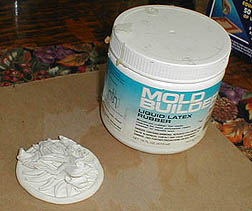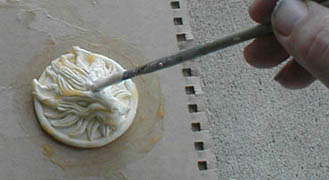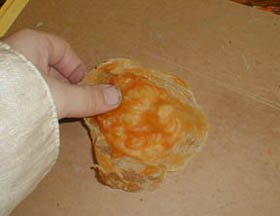

Home / Sculpting / Making a Mold / Casting / Painting / Gem Making Tutorial / Links / Contact Me


There are a lot of materials you can use to make a mold, but I find one of the easiest ones to work with is brush-on latex. You can find tubs of it for sale at many hobby and craft stores. Some drawbacks to this stuff:
(A.) Its smell (it has ammonia in it, so it smells like an overripe litterbox. I'd recommend brushing this stuff on outdoors or in a well-ventilated garage.)
(B.) It's not a good method for those in a hurry. Each brushed-on layer of latex takes a day to dry, and a small object might need several layers of latex to create a usable mold.
Moving on...place the item to be molded on a stiff, thick piece of cardboard and start brushing on the latex (only a thin layer at first.) Make sure to get the latex to fill all the object's nooks and crannies. If you don't, you'll risk losing some of the object's detail when the cast is made. Spread the latex all around the object about a 1/2" or so. This will make the mold more stable and create a sort of lip so the liquid resin doesn't go running down over the sides of the mold when poured.


When the latex is fully dry a day later, it will appear darker and lumpy. Apply a second and subsequent coats, waiting at least 1 day in between coats for the latex to dry. After you've applied at least 3 or more coats, you can, if you wish, apply strips of bandage gauze soaked in latex. This will make the mold stronger (but may make it a little more difficult to peel off. It shouldn't make any difference, however, as far as the final appearance of the cast object is concerned.)
While the latex on that mold dries, I'll show you pictures of a wolf ornament and mold that I made earlier...

Here it is. (You'll find after you've laid down about 6-8 coats, that your mold should be thick enough.) Now comes the tough part: removing the latex from the original object. Grab a corner of the latex and start peeling. The latex will take alot more abuse than you think it will, so don't be squeamish. Pull that baby. If all goes well, you should wind up with a latex shell which has a perfect negative of the cast object on the inside of it. (Don't worry if it looks a little rough. The positive cast should wind up looking nicer than that.)

Next step: Casting using a Latex Mold...
